Did the End Times Already Happen?
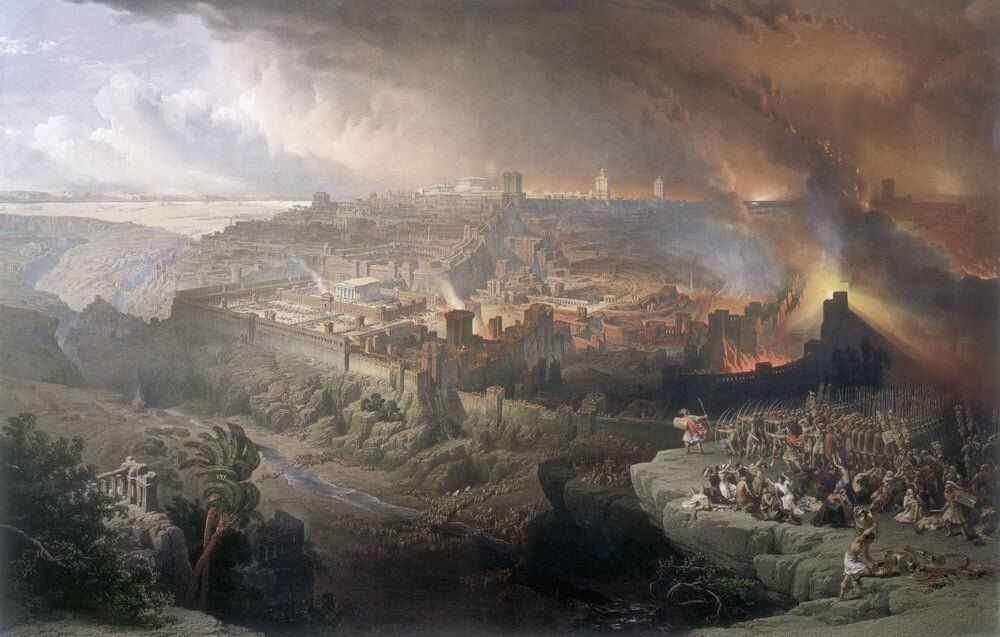
A Critique of Partial Preterism from the Words of Jesus
Many Christians today are “futurists.” They believe that all the signs of Christ’s return haven’t happened yet. These will happen immediately prior to the Second Coming of Christ, also known as the “Parousia” in Greek. However, a minority of Christians are “preterists.” They believe that all the signs of the Parousia, and in some sense, the Parousia itself, have already happened. According to preterists, all these took place in the events surrounding the destruction of the Jewish Temple in 70 A.D.
There are two types of preterism: “partial preterism” and “full/hyper preterism.” Partial preterists believe that the majority of the signs about the Antichrist and Great Tribulation were fulfilled in the 1st Century AD. However, they still await the Second Coming of Christ and general resurrection of the dead in the future. On the other hand, full preterists believe that all of these signs have already been fulfilled, including the Second Coming of Christ and the general resurrection of the dead. Full preterism is heresy, since it goes against the Nicene Creed.
But is partial preterism true? Jesus gave a long speech about the future on the Mount of Olives during the last week of his ministry. Different accounts of this same speech, called the Olivet Discourse, are captured in Matthew 24, Mark 13, and Luke 21. In each version, Jesus describes the coming of the Son of Man, as well as events that would happen prior to that. Therefore, these speeches have many parallel elements.
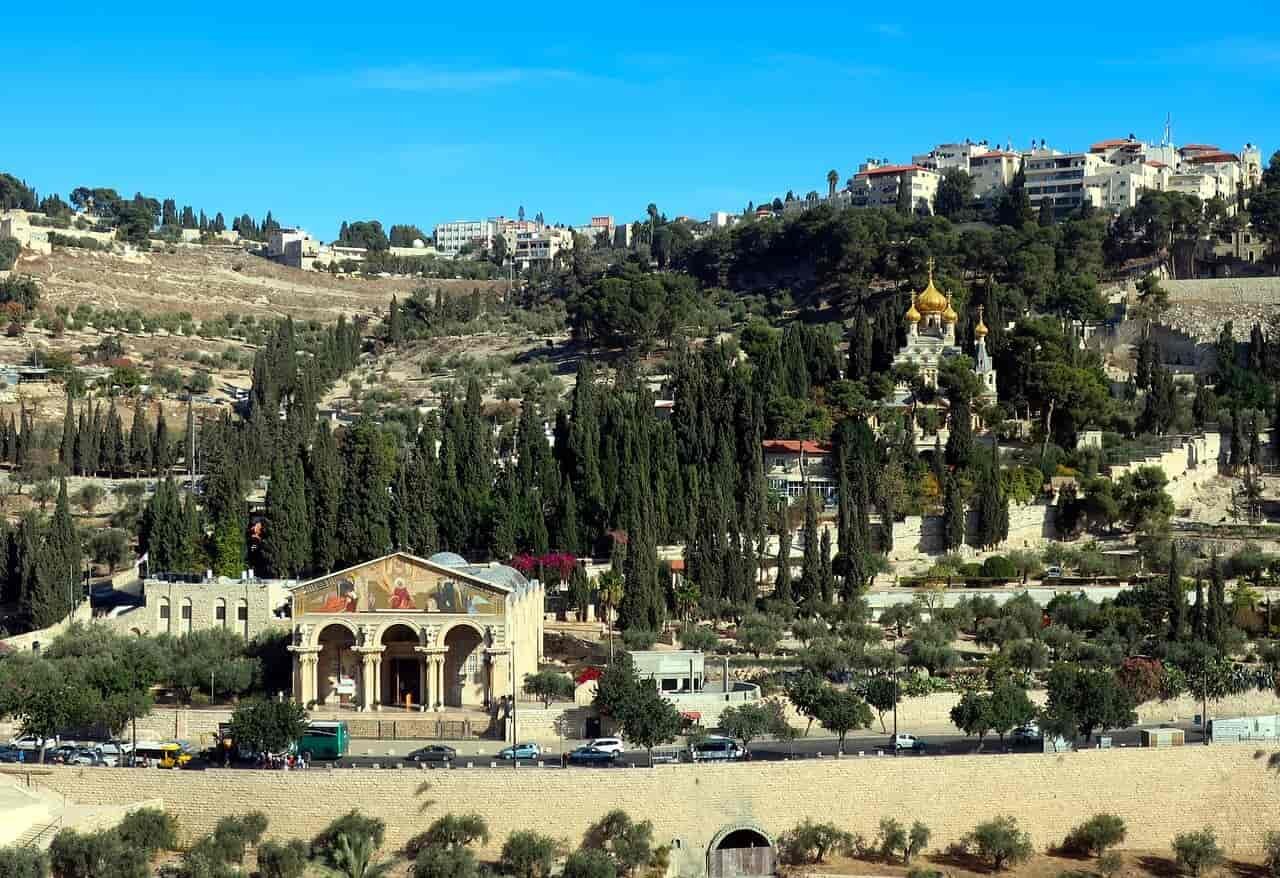
The Mount of Olives
Matthew 24 and Luke 21 Are Not Interchangeable
However, preterists mistakenly believe that these passages are basically interchangeable, describing exactly the same events. Yet the text would lead us to believe otherwise. The author of each version had a different goal in mind when relating the accounts. Each author captured different parts of Jesus’ speech, based on their desired emphasis. Furthermore, the Gospel writers used very careful language to distinguish end-time signs from 1st Century events.
Matthew 24 has the biggest emphasis on the signs immediately prior to Christ’s return. We know this is a theme for several reasons. After describing the signs, Matthew contains several parables about preparedness for the return of Christ. In these parables, he talks as if the Master would be “delayed” (Matt. 25:5) or not come for a “long time” (Matt. 25:19). In addition, the signs are much more global in scope and don’t have historical fulfillments. This is in contrast to Luke 21, which are more local in scope and do have some historical fulfillments.
Furthermore, in Matthew’s account, Jesus narrates the signs in strict chronological order, with little to no backtracking. In this account, Jesus frequently uses the word “then” in a very sequential manner, to describe the signs of his coming. He describes world war, famines, and earthquakes. After this, he describes a global persecution and falling away from the faith. Then he describes an idol in the Jewish temple, called the abomination of desolation. This launches a period of unprecedented trouble which threatens the very existence of humanity. However, “immediately after” this trouble, Jesus comes on the clouds.
However, Luke’s account does not flow in a strictly chronological manner. Luke’s account has similar signs as Matthew’s account. But after describing these, it backtracks, saying “but before all this.” It goes on to describe 1st Century persecutions. After talking about these, Jesus describes the siege of Jerusalem which took place in 70 A.D. Unlike Matthew’s account, the Siege of Jerusalem doesn’t immediately end with the Parousia, but only ends after a long period of exile for ethnic Jews. Only then does Jesus come on the clouds.

Siege of Jerusalem (70 A.D.)
Non-Overlapping Details
Furthermore, Matthew 24 and Luke 21 contain several non-overlapping details when describing the “Jerusalem event” within the speech.
Unique to Matthew 24
- Abomination of desolation (idol in the temple; see discussion of Matt. 24:15 below)
- Must flee immediately without retrieving any possessions
- Pray that it won’t happen in winter or on a Sabbath
- Unprecedented trouble which threatens the very existence of all humanity
- Days are cut short to help the elect
- False christs and false prophets perform extremely deceptive miracles
- Tribulation terminates immediately at the Parousia
Unique to Luke 21
- Jerusalem surrounded by armies
- Days of “vengeance” to fulfill all that is written
- City residents instructed to leave
- People in the country told not to enter the city
- Great distress on earth and “wrath” against the Jews
- Jews fall by the edge of the sword
- Jews taken captive among all nations
- Jerusalem trampled on by Gentiles until “times of the Gentiles” finally end
Common to Both
- “So when you see…”
- Reference to “desolation”
- Let those who are in Judea flee to the mountains
- Dreadful for pregnant women and nursing mothers
- Time of great distress
An examination of the Jerusalem event in Luke 21 and Matthew 24 show that they have more differences than similarities. This is another reason why Matthew 24 and Luke 21 are not directly parallel accounts. This is in contrast with Mark 13, most of which is directly parallel to Matthew 24. We know this because Mark 13 narrates most of the same events as Matthew 24, albeit with slightly different wording.
Yet despite their differences, Matthew 24 and Luke 21 do share some important similarities. Because of this, the fall of Jerusalem in 70 A.D. is a “type” or foreshadowing of end time events. (1)
We’ve seen how Matthew 24 is not just another version of Luke 21 for two reasons. First, the accounts use very careful language to differentiate end time events from 1st Century events. Second, the Jerusalem event in each account contains more differences than similarities. Therefore, they cannot be describing the same thing. As a result, we can conclude that Matthew 24 describes the signs of the Second Coming at the end of the age.
Genre of Matthew 24
One principle of good interpretation is that everything ought to be interpreted according to the sense in which it was written. To quote preterist R.C. Sproul:
What is meant by sensus literalis is not that every text in the Scriptures is given a “woodenly literal” interpretation, but rather that we must interpret the Bible in the sense in which it is written. Parables are interpreted as parables, symbols as symbols, poetry as poetry, didactic literature as didactic literature, historical narrative as historical narrative, occasional letters as occasional letters. That principle of literal interpretation is the same principle we use to interpret any written source responsibly. (2)
What is the genre of the Olivet Discourse according to Matthew? It is part of the book of Matthew, which is in the genre of Greco-Roman biography. This literary genre requires a mostly literal interpretation, with a few exceptions. (3)

Regarding the Olivet Discourse itself, we’ve seen how it is a mostly chronological narrative of future prophecy. Matthew, Mark, and Luke are very precise and specific when indicating time and sequence. Furthermore, Luke 21 narrates several events that we know were literally fulfilled in the past. Finally, Matthew 24 frequently cites terms and ideas from the book of Daniel. The book of Daniel is unique in that it predicts literal future events in a chronological order (Daniel 2, 7, 11-12).
The Olivet Discourse is not a parable, therefore it should not be interpreted allegorically. Nevertheless, it contains multiple object lessons, the literal interpretation of which is very clear. Finally, the passage borrows images about cosmic disturbances surrounding the Day of the Lord in the Old Testament (Isaiah 13; Isaiah 34; Ezekiel 32). Because of this, preterists maintain that it contains non-literal apocalyptic imagery. (4)
As a result, we should take the Olivet Discourse literally whenever possible. A symbolic interpretation should only be allowed when sufficient reason is given for such an interpretation. We will also investigate the claim that a portion of the text contains apocalyptic imagery.
In the following section, we will examine parts of Matthew 24 to see if they pertain to the end times or the 1st Century.
Birth Pains
7 For nation will rise against nation, and kingdom against kingdom, and there will be famines and earthquakes in various places. 8 All these are but the beginning of the birth pains. (Matthew 24: 7-8)
This birth pains reference is Old Testament language about the Day of the Lord:
Wail, for the day of the Lord is near;
as destruction from the Almighty it will come!
7 Therefore all hands will be feeble,
and every human heart will melt.
8 They will be dismayed:
pangs and agony will seize them;
they will be in anguish like a woman in labor.
They will look aghast at one another;
their faces will be aflame.
9 Behold, the day of the Lord comes,
cruel, with wrath and fierce anger,
to make the land a desolation
and to destroy its sinners from it.
10 For the stars of the heavens and their constellations
will not give their light;
the sun will be dark at its rising,
and the moon will not shed its light.
11 I will punish the world for its evil,
and the wicked for their iniquity;
I will put an end to the pomp of the arrogant,
and lay low the pompous pride of the ruthless.
12 I will make people more rare than fine gold,
and mankind than the gold of Ophir.
13 Therefore I will make the heavens tremble,
and the earth will be shaken out of its place,
at the wrath of the Lord of hosts
in the day of his fierce anger. (Isaiah 13:6-13)
In Matthew 24, Jesus mentions “birth pains” (v. 8) as well as the darkening of the sun and moon (v. 29). These are very clear references to the Isaiah 13 passage above. (5) Therefore, Jesus sees world war, famines and earthquakes as signs that Isaiah’s Day of the Lord is in the near future.

Isaiah 13 opens by saying it is an oracle against Babylon. Therefore, parts of Isaiah 13 have a historical fulfillment prior to the time of Christ. Nevertheless, Jesus believes that this chapter wasn’t entirely fulfilled in history. By making allusions to this chapter in his end times speech, he is signaling that parts of this passage have yet to be fulfilled in the future.
This can also be supported by the text itself. In Isaiah 13:6-13, God does something that doesn’t have historical fulfillment. In particular, God says that he will make mankind more rare than “the gold of Ophir.”
Paul also connects the general resurrection of the dead with Isaiah’s Day of the Lord:
16 For the Lord himself will descend from heaven with a cry of command, with the voice of an archangel, and with the sound of the trumpet of God. And the dead in Christ will rise first. 17 Then we who are alive, who are left, will be caught up together with them in the clouds to meet the Lord in the air, and so we will always be with the Lord. 18 Therefore encourage one another with these words.
5 Now concerning the times and the seasons, brothers, you have no need to have anything written to you. 2 For you yourselves are fully aware that the day of the Lord will come like a thief in the night. 3 While people are saying, “There is peace and security,” then sudden destruction will come upon them as labor pains come upon a pregnant woman, and they will not escape. (1 Thessalonians 4:16-5:3)
By mentioning the “birth pains,” Jesus is linking these particular disasters to the end times Day of the Lord in Isaiah 13. However, Paul says this Day of the Lord begins with the general resurrection of all of God’s people. Therefore, Jesus is giving us signs that lead right up to the general resurrection of the dead. This clearly did not happen in the 1st Century.
All Nations
Jesus then describes a global persecution, wherein the followers of Christ are hated by “all nations.” This causes many Christians to fall away from the faith.
9 “Then they will deliver you up to tribulation and put you to death, and you will be hated by all nations for my name's sake. 10 And then many will fall away and betray one another and hate one another. 11 And many false prophets will arise and lead many astray. 12 And because lawlessness will be increased, the love of many will grow cold. (Matthew 24:9-12)
The word here for “nation” is “ethnos.” (6) It refers to every ethnic group, not just every political nation. Clearly, “all nations” didn’t hate the Christians in the 1st Century, because not every ethnic group knew that they existed. Furthermore, we cannot point to a global event in the 1st Century where a large number of Christians throughout the world gave up the faith. Yet this is what Jesus says will happen.

Jesus also says that the gospel must be preached to “all nations” before the end can come.
And this gospel of the kingdom will be proclaimed throughout the whole world as a testimony to all nations, and then the end will come. (Matthew 24:14)
Every ethnic group has not yet heard the Gospel as Jesus predicted. Furthermore, Jesus makes this a prerequisite for “the end” to come. Therefore, there must be some identifiable criteria which determines if this is completed or not.
Preterists counter this, by saying that the Gospel had gone into the whole known “world” by the time Paul was preaching. For example, Paul says:
But I ask, have they not heard? Indeed they have, for
“Their voice has gone out to all the earth,
and their words to the ends of the world.” (Romans 9:18)
The Gospel did go out into the known world in the 1st Century. However, that’s not what verse 14 is saying. It says that “all nations” must hear the Gospel. This is consistent with Matthew 28:19, where Jesus gives the Great Commission:
Go therefore and make disciples of all nations, baptizing them in the name of the Father and of the Son and of the Holy Spirit, (Matthew 28:19).
Even partial preterists believe that the Great Commission is not finished, since the Gospel has not been proclaimed to every ethnic group. (7) Therefore, to be consistent, we must say that Matthew 24:14 hasn’t been fulfilled either.
Revelation reinforces this point, saying:
9 After this I looked, and behold, a great multitude that no one could number, from every nation, from all tribes and peoples and languages, standing before the throne and before the Lamb, clothed in white robes, with palm branches in their hands, 10 and crying out with a loud voice, “Salvation belongs to our God who sits on the throne, and to the Lamb!” (Revelation 7:9-10)
This is hardly symbolic, because it agrees with the literal meaning of Matthew 24:14, albeit more explicitly. As a result, this most certainly did not happen in the 1st Century.
But what about Romans 16:26?
25 Now to Him who is able to establish you according to my gospel and the preaching of Jesus Christ, according to the revelation of the mystery which has been kept secret for long ages past, 26 but now is manifested, and by the Scriptures of the prophets, according to the commandment of the eternal God, has been made known to all the nations, leading to obedience of faith; 27 to the only wise God, through Jesus Christ, be the glory forever. Amen. (Romans 16:25-27)
Is Paul saying that the Gospel has been literally made known to every ethnic group? Not necessarily. First, it is demonstrably false that the Gospel went to every nation by the time Paul wrote his letter to the Romans. People in modern-day China and the Americas hadn’t heard the Gospel. Second, Paul is contrasting this present age with previous ages. (8) In this present age, the Gospel has been made available to all nations. However, in ages past, this was not the case. This interpretation is preferable to the idea that Paul is saying that the Great Commission has been fully completed.
The Abomination of Desolation
“So when you see the abomination of desolation spoken of by the prophet Daniel, standing in the holy place (let the reader understand), (Matthew 24:15)
Here Jesus mentions the "abomination of desolation.” Jesus makes special note that the reader of the book of Daniel should understand what the term means. Though confusing for us, his wise listeners would be familiar with this term, as they were aware of the story behind Hanukkah.
The abomination of desolation is referenced only three times in the Old Testament, all of which are in the book of Daniel. Two refer to a future event, while one refers to a past event. Daniel 11:31 says:
Forces from him shall appear and profane the temple and fortress, and shall take away the regular burnt offering. And they shall set up the abomination that makes desolate. (Daniel 11:31)
This was fulfilled in 168 B.C. when Antiochus IV Epiphanes invaded Israel. He set up an altar and idol of Zeus on the temple altar. After a successful revolt, the temple was rededicated. This re-dedication is celebrated every year during Hanukkah. Throughout the Old Testament, “abominations” often refer to idols. Furthermore, the image set up by Antiochus caused the temple area to be abandoned in disgust and horror, making it “desolate.” This historical fulfillment, as well as the language itself, show that the phrase “abomination of desolation” is a technical term for an idol in the Jewish temple. (9,10,11,12,13)
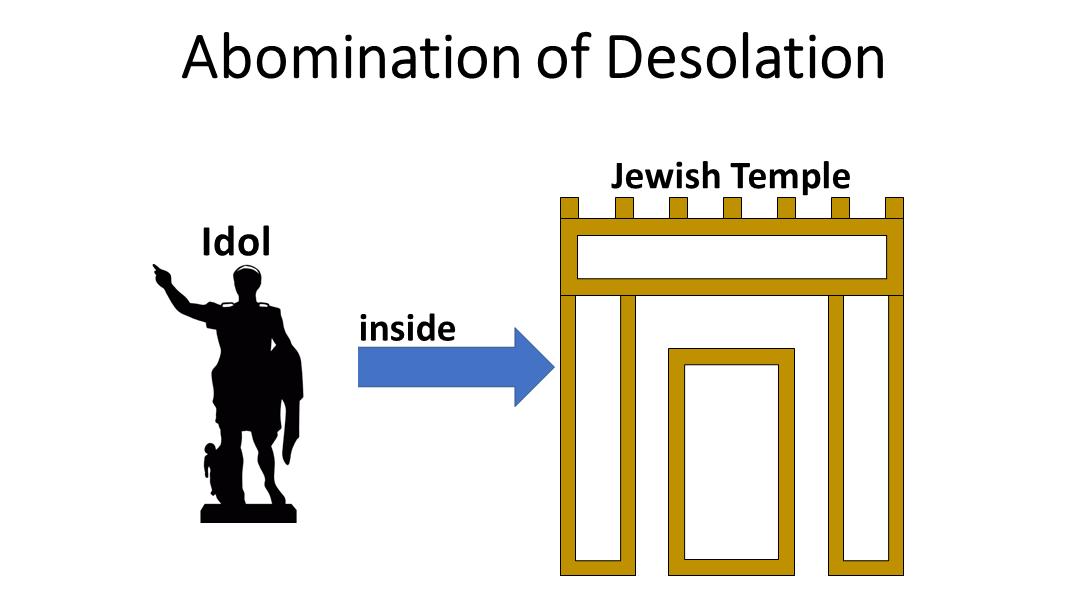
However, Daniel 9:27 implies the end time abomination of desolation is a person, not just a statue. It says:
And he shall make a strong covenant with many for one week, and for half of the week he shall put an end to sacrifice and offering. And on the wing of abominations shall come one who makes desolate, until the decreed end is poured out on the desolator. (Daniel 9:27)
Jesus also indicates this in Mark 13, which is the parallel passage to Matthew 24:
But when you see the abomination of desolation standing where he ought not to be (let the reader understand), then let those who are in Judea flee to the mountains. (Mark 13:14)
In the end times, the idol is the Antichrist himself. Paul clarifies this for us when he says:
Let no one deceive you in any way. For that day will not come, unless the rebellion comes first, and the man of lawlessness is revealed, the son of destruction, who opposes and exalts himself against every so-called god or object of worship, so that he takes his seat in the temple of God, proclaiming himself to be God.” (2 Thessalonians 2:3-4)
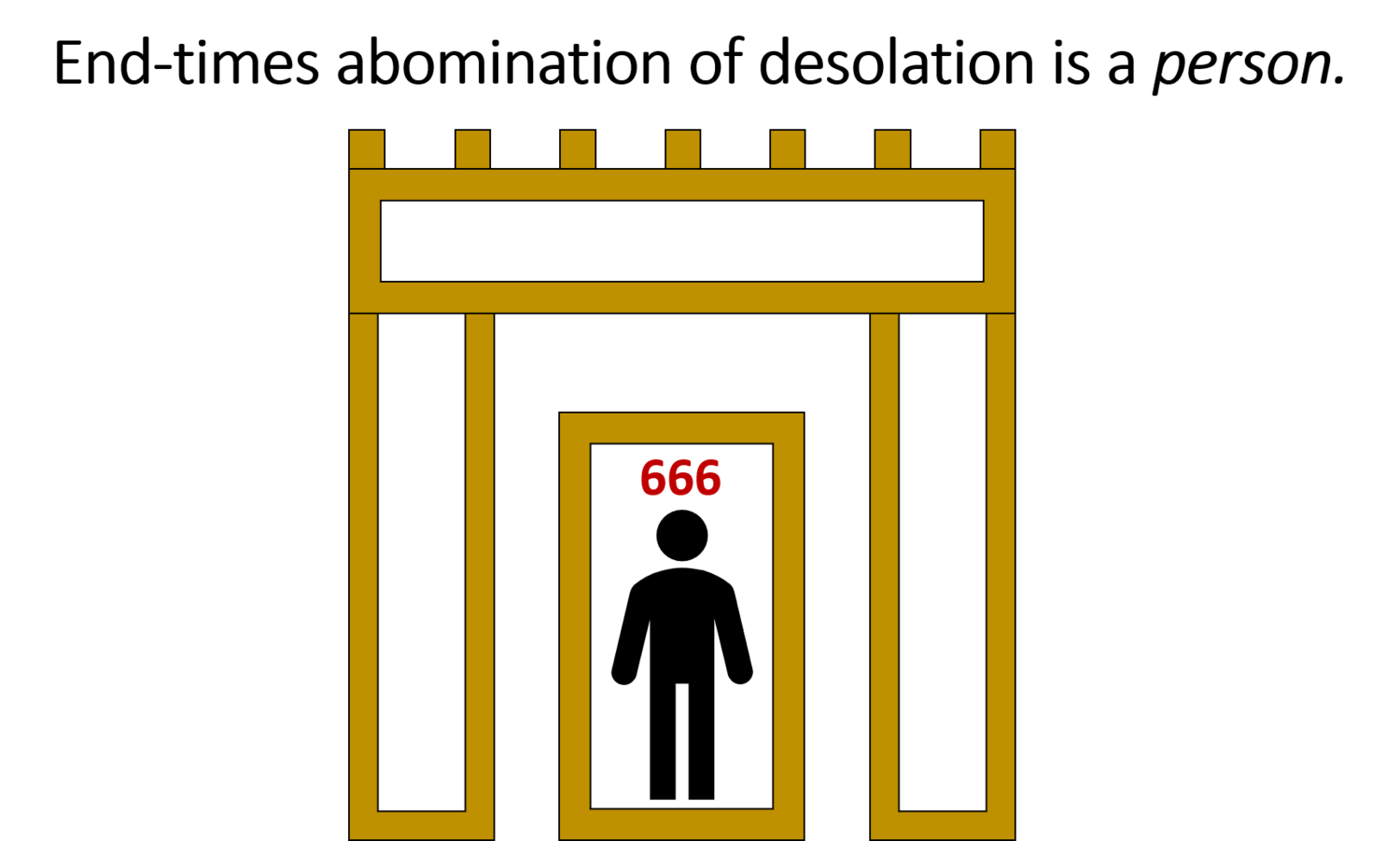
No one in the first century set themselves up as God in the Jewish temple. On the contrary, the temple was destroyed in the 1st Century, not desecrated in this manner. In addition, Paul goes on to describe the defeat of this “man of lawlessness” at the coming of Jesus.
And then the lawless one will be revealed, whom the Lord Jesus will kill with the breath of his mouth and bring to nothing by the appearance of his coming. (2 Thessalonians 2:8)
This cross-references to Isaiah 11, which describes the Messiah:
3 And his delight shall be in the fear of the Lord.
He shall not judge by what his eyes see,
or decide disputes by what his ears hear,
4 but with righteousness he shall judge the poor,
and decide with equity for the meek of the earth;
and he shall strike the earth with the rod of his mouth,
and with the breath of his lips he shall kill the wicked. (Isaiah 11:3-4)
Jesus did not make a visual appearance in 70 A.D., nor did he kill a notorious blasphemer at the destruction of the Jerusalem temple. Therefore, the abomination of desolation that Jesus describes pertains to the future.
Great Tribulation
Nevertheless, upon seeing the abomination of desolation, the worst time in human history begins:
For then there will be great tribulation, such as has not been from the beginning of the world until now, no, and never will be. 22 And if those days had not been cut short, no human being would be saved. But for the sake of the elect those days will be cut short. (Matthew 24:21-22)
Jesus describes this time of “Great Tribulation” as the worst in human history. Up to 1 million Jews were killed at the Siege of Jerusalem in 70 A.D. However, 6 million Jews were killed in the Jewish Holocaust in the 20th Century. Therefore, the Jewish Holocaust was a worse time in history than 70 A.D. While WWII was not the Great Tribulation, it goes to show that the 70 A.D. was not the Great Tribulation either, since it was not unprecedented.
Jesus implies that this Great Tribulation affects the “world,” not just the Jews. Furthermore, Jesus says that no human being would be “saved” if it were to continue. Here, Jesus uses a term pasa sarx, which is almost always used in the New Testament to describe everyone on earth. As a result, the Great Tribulation threatens the survival of everyone on earth. Therefore, we cannot limit this Great Tribulation to Israel only. (14)

23 Then if anyone says to you, ‘Look, here is the Christ!’ or ‘There he is!’ do not believe it. 24 For false christs and false prophets will arise and perform great signs and wonders, so as to lead astray, if possible, even the elect. 25 See, I have told you beforehand. (Matthew 24:23-25)
Paul also talks about this when he says:
9 The coming of the lawless one is by the activity of Satan with all power and false signs and wonders, 10 and with all wicked deception for those who are perishing, because they refused to love the truth and so be saved. 11 Therefore God sends them a strong delusion, so that they may believe what is false, 12 in order that all may be condemned who did not believe the truth but had pleasure in unrighteousness. (2 Thessalonians 2:9-12)
Both Jesus and Paul make these miracles sound quite impressive. Paul says that these cause a “strong delusion.” Jesus says that the miracles are so convincing that they could even deceive the elect, if that was even possible.
Unfortunately for the preterist, there is no basis for thinking that this happened in the 1st Century. No one was able to do counterfeit miracles to such a degree that it put most Christians salvation at risk. Nor was anyone causing the whole world to go astray through their miracles. This is in sharp contrast to Revelation 13, where two individuals delude the entire world through demonically empowered miracles.
The Coming of the Son of Man
26 So, if they say to you, ‘Look, he is in the wilderness,’ do not go out. If they say, ‘Look, he is in the inner rooms,’ do not believe it. 27 For as the lightning comes from the east and shines as far as the west, so will be the coming of the Son of Man. 28 Wherever the corpse is, there the vultures will gather. (Matthew 24:26-28)
Jesus goes to great pains to tell people not to go after the false christs and false prophets. He specifically states that, if you have to go anywhere or do anything to see him, then he is not the Messiah. By using the lightning metaphor, he is explaining that it doesn’t matter where you are, that his coming will still be visible.
However, preterists claim that Jesus came in judgment on Jerusalem in 70 A.D. (4) This allegedly fulfills Matthew 24:30 about the “coming of the Son of Man.” Unfortunately, this event was entirely invisible. This directly contradicts this passage, which says that the coming of the Son of Man will be visible everywhere, like lightning. Nor is it a minor issue, since the visibility of Jesus’ coming is the means by which someone distinguishes between the true Christ and false Christs. This is probably the most serious problem with the preterist view. (15)
“Immediately after the tribulation of those days the sun will be darkened, and the moon will not give its light, and the stars will fall from heaven, and the powers of the heavens will be shaken. (Matthew 24:29)
Preterists interpret this as non-literal apocalyptic imagery. (4) To support this conclusion, they cite the cosmic disturbances in Isaiah 13, Isaiah 34 and Ezekiel 32. Unfortunately, Isaiah 13 is of no help to the preterist, because it appears that both Jesus and Paul believed that the Isaiah 13 passage has future application other than what was to happen to Babylon before Christ. We know this because Jesus mentions birth pains and the darkening of the sun and moon as a future prediction (see discussion of Matt. 24:8 above).

Isaiah 34 is also no help to the preterist, because it contains unfulfilled predictions about the destruction of Edom. People still live in the land of Edom today, which is in southwestern Jordan. Furthermore, the book of Obadiah details unfulfilled predictions about the annihilation of the Edomites. Therefore, Isaiah 34 remains unfulfilled.
8 For the Lord has a day of vengeance,
a year of recompense for the cause of Zion.
9 And the streams of Edom shall be turned into pitch,
and her soil into sulfur;
her land shall become burning pitch.
10 Night and day it shall not be quenched;
its smoke shall go up forever.
From generation to generation it shall lie waste;
none shall pass through it forever and ever.
11 But the hawk and the porcupine shall possess it,
the owl and the raven shall dwell in it.
He shall stretch the line of confusion over it,
and the plumb line of emptiness.
12 Its nobles—there is no one there to call it a kingdom,
and all its princes shall be nothing. (Isaiah 34:8-12)
The same could be said of Ezekiel 32. It’s not entirely clear that this is a historical prophecy about Pharaoh. This is further supported by the fact that Isaiah 19 contains several unfulfilled prophecies about Egypt. Therefore, preterists cannot use the astronomical phenomena in this chapter as proof that it is non-literal apocalyptic imagery.
30 Then will appear in heaven the sign of the Son of Man, and then all the tribes of the earth will mourn, and they will see the Son of Man coming on the clouds of heaven with power and great glory. (Matthew 24:30)
This verse is especially problematic for preterists, because Jesus previously said that the way to differentiate him from false Messiahs was that he would be visible everywhere, like lightning. But here, it explicitly says that everyone will see the Son of Man in the sky.
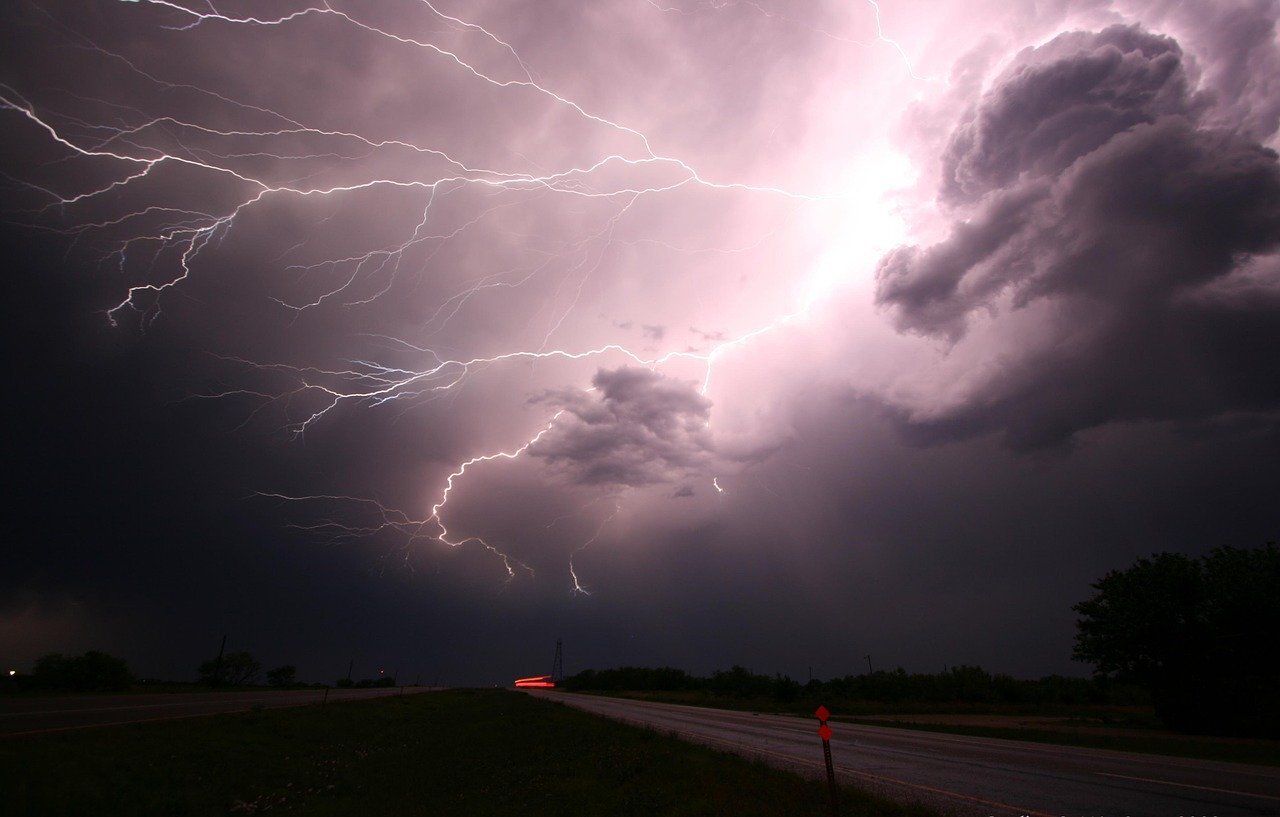
However, on the preterist view, this verse means virtually nothing, as not even the destruction of the Jerusalem temple was globally visible. Furthermore, no one in the 1st Century realized that it was the “coming of the Son of Man”, not even the Christians.
Some say that this too is symbolic imagery of God riding the clouds. Preterists sometimes point to Isaiah 19:1 for proof of this. (7)
An oracle concerning Egypt.
Behold, the Lord is riding on a swift cloud
and comes to Egypt;
and the idols of Egypt will tremble at his presence,
and the heart of the Egyptians will melt within them. (Isaiah 19:1)
However, this assumes that Isaiah 19 does not have an end times application. Indeed, it can be shown that Isaiah 19 is primarily about the end times. This passage contains several unfulfilled prophecies including:
- An Egyptian civil war
- The drying of the Nile
- A hard master ruling over the Egyptians
- God sending a savior to Egypt
- Egyptians and Assyrians going up to worship God
Furthermore, Matthew 24:30 states that “all the tribes of the earth will mourn.” This cross-references to Zechariah, which talks about a national mourning for Israel, when they realize Jesus is the Messiah.
“And I will pour out on the house of David and the inhabitants of Jerusalem a spirit of grace and pleas for mercy, so that, when they look on me, on him whom they have pierced, they shall mourn for him, as one mourns for an only child, and weep bitterly over him, as one weeps over a firstborn. (Zechariah 12:10)
This most certainly did not happen at the destruction of the Jerusalem temple. Israel did not engage in national repentance, nor did they see Jesus in any way shape or form. (16) If anything, they continued to hide their faces from him, having spent the previous few decades persecuting the apostles.
This problem is compounded because Jesus says “all the tribes of the earth” will mourn his coming, not just the Jews. This can be backed up by the book of Revelation as well, which says that “every eye” will see him.
Behold, he is coming with the clouds, and every eye will see him, even those who pierced him, and all tribes of the earth will wail on account of him. Even so. Amen. (Revelation 1:7)
Immediately after this, Jesus gathers his people to himself:
And he will send out his angels with a loud trumpet call, and they will gather his elect from the four winds, from one end of heaven to the other. (Matthew 24:31)
A preterist interpretation demands that we take this sentence figuratively for the spread of the Gospel. (7) But why? The literary genre of the Olivet Discourse does not allow us to interpret this figuratively. Furthermore, there is no Old Testament precedent that allows us to interpret this figuratively.
This description of the gathering of God’s people to Jesus is very similar to Paul’s description of the “coming of the Lord” in 1 Thessalonians 4:15-18:
15 For this we declare to you by a word from the Lord, that we who are alive, who are left until the coming of the Lord, will not precede those who have fallen asleep. 16 For the Lord himself will descend from heaven with a cry of command, with the voice of an archangel, and with the sound of the trumpet of God. And the dead in Christ will rise first. 17 Then we who are alive, who are left, will be caught up together with them in the clouds to meet the Lord in the air, and so we will always be with the Lord. 18 Therefore encourage one another with these words. (1 Thessalonians 4:15-18)
This comparison chart shows how the “coming of the Lord” described by Paul is the same as the “coming of the Son of Man” described by Jesus:
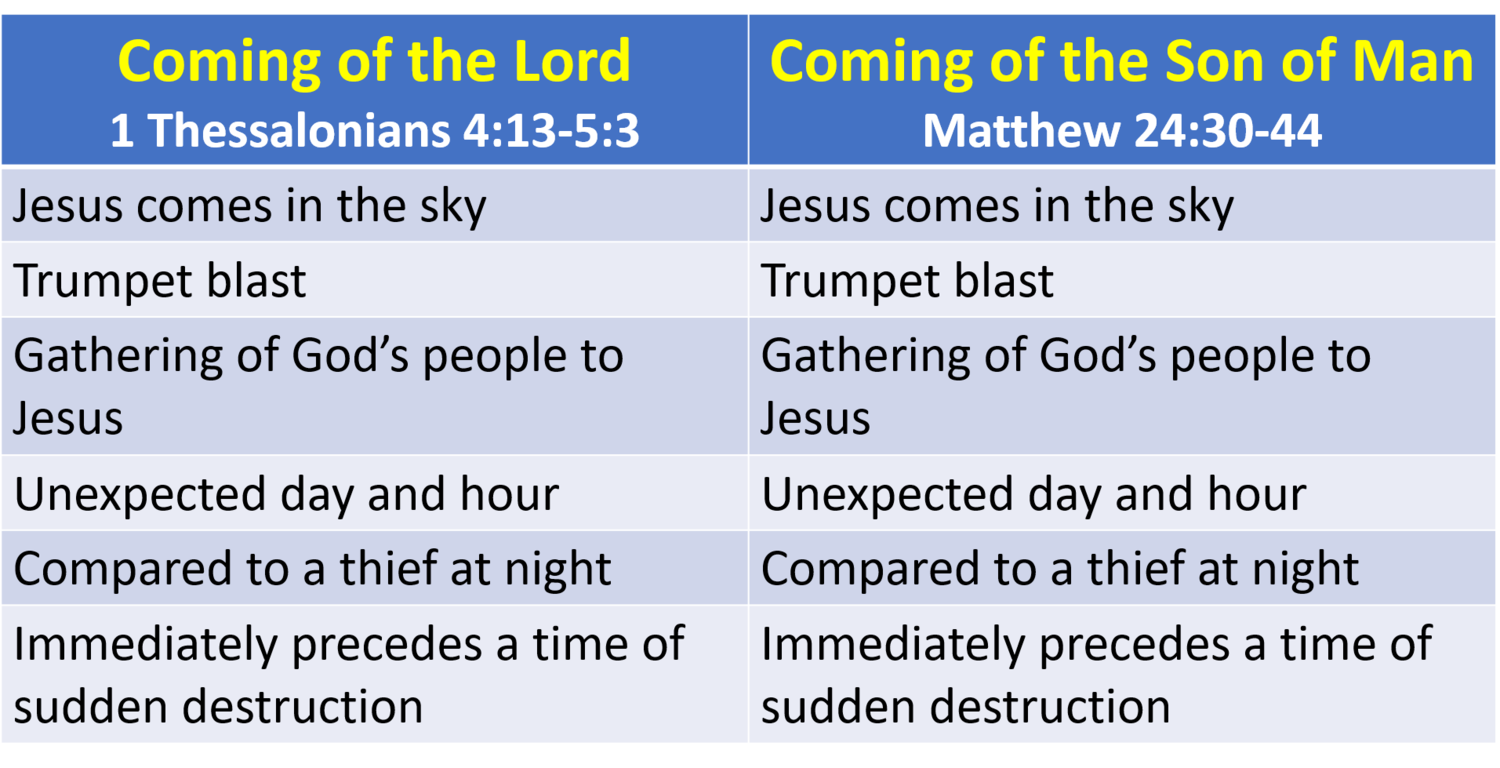
Furthermore, even the signs of this event are the same in both Jesus and Paul. If we “zoom out” to view the whole end times narrative, we get a similar result:

This Generation
For a discussion on the following verses, see this article.
32 “From the fig tree learn its lesson: as soon as its branch becomes tender and puts out its leaves, you know that summer is near. 33 So also, when you see all these things, you know that he is near, at the very gates. 34 Truly, I say to you, this generation will not pass away until all these things take place. (Matthew 24:32-34)
Other Time Texts
Truly, I say to you, there are some standing here who will not taste death until they see the Son of Man coming in his kingdom.” (Matthew 16:28)
The kingdom of God has an “already/not yet” dimension to it. (7) Sometimes, discussion of the present kingdom is right next to discussion of the Parousia (Luke 17:20-24). Therefore, this verse here doesn’t have to refer to the Second Coming.
Luke’s parallel account is much more modest:
26 For whoever is ashamed of me and of my words, of him will the Son of Man be ashamed when he comes in his glory and the glory of the Father and of the holy angels. 27 But I tell you truly, there are some standing here who will not taste death until they see the kingdom of God.” (Luke 9:26-27)
Furthermore, in each of the synoptic Gospels, this is followed by the Transfiguration. Of note, only some of the disciples were present for this, which is in keeping with the statement that there were “some'' standing there who wouldn't taste death before seeing Jesus come in his kingdom.

The Transfiguration
Indeed, Peter even uses this “coming” language to describe the Transfiguration (7):
16 For we did not follow cleverly devised myths when we made known to you the power and coming of our Lord Jesus Christ, but we were eyewitnesses of his majesty. 17 For when he received honor and glory from God the Father, and the voice was borne to him by the Majestic Glory, “This is my beloved Son, with whom I am well pleased,” (2 Peter 1:16-17)
This interpretation is easily preferable to the idea that the Second Coming has already happened, which is a non-starter because such a coming was invisible and unrecognized by anyone living at that time period.
When they persecute you in one town, flee to the next, for truly, I say to you, you will not have gone through all the towns of Israel before the Son of Man comes. (Matthew 10:23)
The “you” in this passage is representative of all believers ever, not just the disciples. This is consistent with how it is used throughout Matthew (Matt. 5:11-7:20; 13:11-17; 18:3; 18:15-19; 20:25-27; 23:11; 21:21-22; 26:27-29; 28:16-20). (7)
As a result, this verse is easily explained by the fact that the disciples did not go through all the towns of Israel, because Israel rejected the message and the mission focus shifted to Gentiles. (19, 20) Nor has every town in Israel been evangelized today.
Summary
There are three main problems with a partially preterist interpretation of Jesus’ teachings.
First, preterists mistakenly believe that Matthew 24 and Luke 21 are interchangeable, describing the same events. They overlook key sequential indicators in Matthew 24 and Luke 21, which differentiate end-time events from 1st Century events. Furthermore, they overlook non-overlapping details in each of the accounts.
Second, a literal exegesis of the Olivet Discourse reveals several unfulfilled prophecies from the standpoint of the year 2020. Therefore, these could not have been fulfilled in 70 A.D. A literal interpretation of the Olivet Discourse is supported by the genre of the text involved. It is a chronological prophecy within the genre of Greco-Roman biography. It is not a parable, nor does it contain non-literal apocalyptic imagery.
Third, the time texts in Matthew, which motivate preterism, can be read in a relatively straightforward manner without resorting to the idea that the Parousia already happened. Therefore, the preterist contention that these are restrictive “time texts” falls apart. These statements are to be understood in the plain sense, while accounting for the existence of figures of speech.
End Notes:
- Blaising, Craig A. “2014 09 04 CFC Lecture Blaising Craig.” Youtube.com, October 15, 2014. https://www.youtube.com/watch?v=wi87E3iBliQ.
- Sproul, R.C. “Knowing Scripture by R.C. Sproul.” Ligonier Ministries. Accessed April 4, 2020. https://www.ligonier.org/learn/articles/knowing-scripture/.
- Licona, Michael R. “Why Are There Differences in the Gospels?” Youtube.com, January 5, 2018. https://www.youtube.com/watch?v=aF6_zwYVa3A.
- Sproul, R. C. The Last Days According to Jesus. Grand Rapids: Baker Books, 2003.
- Blaising, Craig A., Alan Hultberg, and Douglas J. Moo. Three Views on the Rapture: Pretribulation, Prewrath, Posttribulation. Grand Rapids, MI: Zondervan, 2010.
- “Strong's Greek: 1484. Ἔθνος (Ethnos) -- a Race, a Nation, Pl. the Nations (as Distinct from Isr.).” Bible Hub. Accessed April 4, 2020. https://biblehub.com/greek/1484.htm.
- Hollett, Brock David. Debunking Preterism: How Over-Realized Eschatology Misses the "Not Yet" of Bible Prophecy, 2018.
- Stifler, James M. The Epistle to the Romans. Chicago, IL: Moody Press, 1960.
- Ginzberg, Louis. "JewishEncyclopedia.com." ABOMINATION OF DESOLATION - JewishEncyclopedia.com. Accessed November 2, 2018. http://www.jewishencyclopedia.com/articles/353-abomination-of-desolation.
- MacArthur, John. "The Abomination of Desolation." Grace to You. October 16, 2017. Accessed November 2, 2018. http://www.gty.org/library/bibleqnas-library/QA0093/the-abomination-of-desolation.
- Price, Randall. "Abomination of Desolation :: By Randall Price (PDF)." Rapture Ready. January 24, 2017. Accessed November 2, 2018. http://www.raptureready.com/2015/04/07/abomination-of-desolation-by-randall-price-pdf.
- Zuck, Roy B., and John F. Walvoord. The Bible Knowledge Commentary: An Exposition of the Scriptures by Dallas Seminary Faculty: Old Testament. Wheaton, IL: Victor Books, 1985.
- Ice, Thomas D. "Part 13 - Matthew 24:15 The Abomination of Desolation by Thomas Ice." Blue Letter Bible. Accessed November 2, 2018. https://www.blueletterbible.org/Comm/ice_thomas/Mat24-25/Mat24-25_Part13.cfm.
- Ice, Thomas D. “Part 17 - Matthew 24:22 The Cutting Short of Days by Thomas Ice.” Blue Letter Bible. Accessed April 4, 2020. https://www.blueletterbible.org/Comm/ice_thomas/Mat24-25/Mat24-25_Part17.cfm.
- Craig, William Lane. “Doctrine of the Last Things Part 4: The Preterist View.” Youtube.com, August 1, 2014. https://www.youtube.com/watch?v=a7NSBjGy7m0.
- Ice, Thomas. “Part 27 - Matthew 24:30 A Signless Sign? by Thomas Ice.” Blue Letter Bible. Accessed April 4, 2020. https://www.blueletterbible.org/Comm/ice_thomas/Mat24-25/Mat24-25_Part27.cfm.
- Nelson, Neil D. “‘THIS GENERATION’ IN MATT 24:34: A LITERARY CRITICAL PERSPECTIVE .” Journal of the Evangelical Theological Society 38, no. 3 (September 1996): 369–85. https://www.etsjets.org/files/JETS-PDFs/38/38-3/JETS_38-3_Nelson_369-386.pdf.
- DeWaay, Bob. “A Solution to the Problem of ‘This Generation’ in Matthew 24:34.” Critical Issues Commentary. Accessed April 4, 2020. https://cicministry.org/commentary/issue77.htm.
- Mayhue, Richard L. “JESUS: A PRETERIST OR A FUTURIST?*.” The Master's Seminary Journal 14, no. 1 (2003): 9–22. https://www.tms.edu/m/tmsj14a.pdf.
- Ice, Thomas D. “Has Bible Prophecy Already Been Fulfilled?” Article Archives, May 2009. https://digitalcommons.liberty.edu/pretrib_arch/96.
- “Scripture quotations are from The ESV® Bible (The Holy Bible, English Standard Version®), copyright © 2001 by Crossway, a publishing ministry of Good News Publishers. Used by permission. All rights reserved.”
Photo Credits:
- Mount of Olives: https://pixabay.com/photos/mount-of-olives-jerusalem-israel-4918087/
- Siege of Jerusalem (70 AD) https://en.wikipedia.org/wiki/Siege_of_Jerusalem_(70_CE)#/media/File:Ercole_de_Roberti_Destruction_of_Jerusalem_Fighting_Fleeing_Marching_Slaying_Burning_Chemical_reactions_b.jpg
- Bible: https://pixabay.com/photos/book-bible-open-glasses-1936547/
- Woman in hospital bed: https://commons.wikimedia.org/wiki/File:Hospital-840135_1920.jpg
- Photomontage faces: https://pixabay.com/illustrations/photomontage-faces-photo-album-1514220/
- Caesar icon: https://www.freepik.com/free-icon/julie-caesar-statue_702484.htm
- Nuclear bomb:https://pixabay.com/photos/nuclear-atom-bomb-atomic-science-2136244/
- Blood moon: https://commons.wikimedia.org/wiki/File:Super,_Blue,_Blood_Moon_(39894649154).jpg
- Lightning: https://pixabay.com/photos/lightning-thunder-lightning-storm-1056419/
- Pharisees question Jesus: https://commons.wikimedia.org/wiki/File:Brooklyn_Museum_-_The_Pharisees_Question_Jesus_(Les_pharisiens_questionnent_J%C3%A9sus)_-_James_Tissot.jpg
- The transfiguration: https://commons.wikimedia.org/wiki/File:Transfiguration_bloch.jpg
